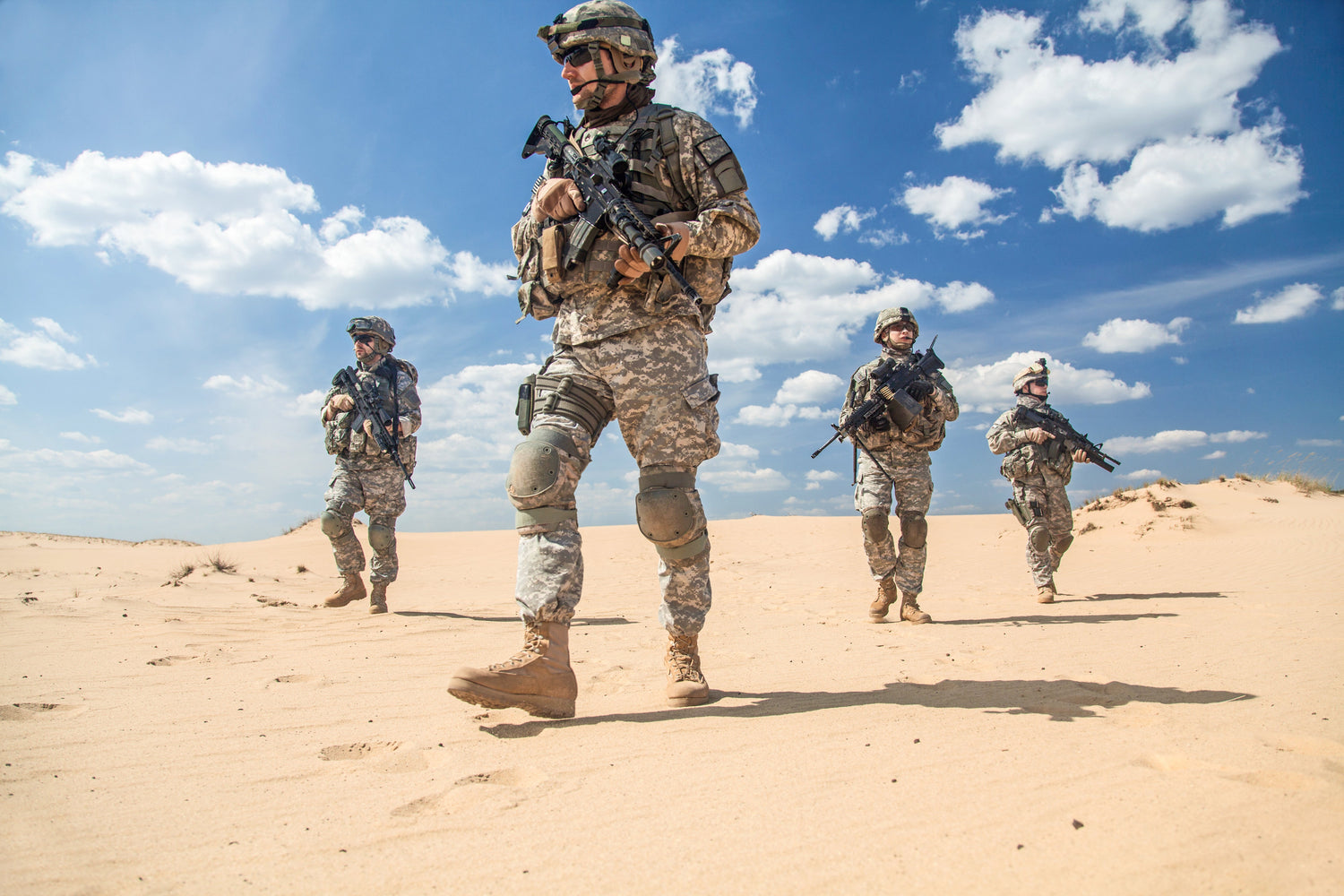Desert Camouflage Challenges: Adapting Camouflage Techniques for Desert Environments
Military camouflage in desert zones is not limited to visual concealment. It neutralizes multiple signatures simultaneously: visual, thermal, radar, electronic.
The desert environment is extremely hostile. Moreover, aridity, intense luminosity, and lack of natural shelter make camouflage complex. Sensors evolve rapidly. Technological and tactical solutions must be cutting-edge
This article explores three dimensions: first the main obstacles; next modern methods to address them; finally historical and contemporary cases that illustrate these challenges.
1. Natural Desert Constraints Making Camouflage Complex
1.1 Light Intensity and Visual Contrast
The desert concentrates powerful direct light. Surfaces are highly reflective. Result: contours accentuate, shadows become pronounced.
Any object whose texture, tint or shape contrasts with the landscape becomes easily detectable. The light saturation phenomenon reduces visual dynamics. Patterns must break sharp lines rather than perfectly imitate local color.
Additional problem: sand nuances vary extremely from one site to another. From light beige to dark ocher or reddish — depending on iron presence, depending on soil type. A "universal" pattern quickly becomes ineffective.
1.2 Extreme Temperatures and Thermal Signature
At the heart of desert days, temperatures can exceed 50 °C. Surfaces accumulate heat: metal, paint, equipment.
During nightfall or in shade, these surfaces release infrared energy. Enemy thermal sensors capture it immediately. The challenge: reduce the differential thermal emissivity between the camouflaged object and surrounding ground.
Important precision: infrared cameras can detect differences of barely 0.01 °C. This extreme sensitivity makes the fight against thermal signatures particularly demanding.
1.3 Absence of Relief and Natural Cover
Forests offer vegetation. Mountainous zones offer relief. The desert offers neither.
Very little relief, very few rocks, very little vegetation to break silhouettes. Troops and vehicles are therefore often "exposed." To compensate for this deficiency, artificial structures are used: nets, textured tarps, decoys. But these devices must themselves be camouflaged correctly.
Aggravating factors: sandstorms, shifting micro-dunes, terrain harshness. They can rapidly degrade or alter fixed camouflage.
2. Visual Camouflage Strategies Adapted for Desert | Desert Camouflage
2.1 Uniforms and Camouflage Patterns
Pattern choice is crucial.
Desert patterns called "pixelated" or digital fragment the silhouette — provided their tints are well-adjusted to the operating zone. Furthermore, technology uses perceptual fragmentation.
Daguet Camouflage (France). Combines horizontal sand and brown bands. Introduced during Operation Daguet. Objective: blend into local desert tones. Performance: effective in Gulf deserts.
Multi-terrain patterns. Other armies adopt modular patterns. CADPAT AR for Canada, for example. Compromise: less specialized, more versatile.
2.2 Concealment Using Nets and Coatings
Camouflage nets fulfill three functions: diffuse light, break angles, slightly absorb/reflect rays. Consequently, the result is fusion with the environment.
Biological compasses are used — mimicking dunes, stones — and 3D textures to approach surrounding relief.
Some coatings include infrared particles to reduce IR signature. Integrated approach: visual camouflage + thermal camouflage simultaneously.
Tactical complement: decoys. Fake tents, fake vehicles divert attention from actually occupied points. Principle: exploits observers' limited resources.
2.3 Active and Adaptive Camouflage
The rise of intelligent sensors pushes toward adaptive materials.
"Smart" fabrics, "active camouflage" adjust their visual and thermal properties in real time. Academic research shows graphene-based coatings capable of modulating their thermal emission according to environment. Complex technology. Remarkable potential.
More recent advances: micro and nano structures (metamaterials) locally control thermal emissivity pixel by pixel. As a result, the surface becomes "visually and thermally continuous" with the environment. Next-generation camouflage.
3. Reducing Thermal Signature in the Desert | Desert Camouflage
3.1 Thermal Detection Mechanisms
Infrared sensors detect temperature differences between an object and the background.
In a desert where ground surface is already very hot, a hotter vehicle or soldier will be immediately detected. Goal of thermal camouflage: mask or equalize this difference. However, its realization is complex.
3.2 Thermal Reduction Technologies
Four main approaches:
Thermoregulating paints and coatings. Contain reflective particles or low-emissivity components. Limit heat diffusion from the object. Application: vehicles, fixed equipment.
Adaptive matrices. Electrochromic surfaces (certain oxides) can change their IR emissivity according to electrical activation. Reactive camouflage: adapts to conditions.
Thermal nets. Composed of insulating or reflective fibers. Create a barrier between object and open air. Multilayer protection.
Nakidka. This coating developed in Russia for armored vehicles reduces optical, IR and radar signatures. Performance: decreases infrared signature by a factor of 2 to 3, radar signature up to 6 times according to its designers. Multispectral integrated system.
3.3 Adaptations for Personnel
For the soldier, uniforms integrate insulating layers. Objective: limit immediate dissipation of body heat.
Additionally, in fixed positions, shade or cooling structures can be installed. Prevent an object from becoming an obvious "hot source." Tactic: local ambient temperature management.
4. Historical References and Contemporary Cases | Desert Camouflage
4.1 Operation Desert Storm (1991)
During the Gulf War, allied forces extensively used "six-color desert camo" uniforms. Sand, light brown, beige tones blended into Kuwait and Saudi Arabia landscape.
These patterns were designed to counter visual imagery. At the time, adversary thermal capabilities were lesser than today. Different technological context.
4.2 Daguet Camouflage (France)
France adopted the "Daguet" pattern for its desert interventions. Horizontal sand and light brown bands adapted to Gulf desert tonality. Ultimately, regional specialization remains the principle of effectiveness.
4.3 Western Sahara Conflict
Rebel or local forces often exploit simple but effective methods.
Cover vehicles with local canvases, place dunes, use local construction materials to camouflage from aerial detection. Result: identification difficult even from drones. Lesson: ingenuity compensates for sophistication.
4.4 Contemporary Camouflage and Counter-Drone
The rise of drones and sophisticated sensors forces armies to invent new responses.
- Thermal decoys. Use "false heat signatures" to fool infrared sensors. Thermal diversion tactic.
- Adversarial patches. Applied to surfaces: small patterns designed to fool automated detection algorithms from aerial images. Artificial intelligence: can be tactically deceived.
- Multidimensional camouflage. Integrates low signatures simultaneously visual, IR and radar for multi-spectrum stealth. Global approach: fusion of protections.
5. Best Practices and Tactical Recommendations | Desert Camouflage
5.1 Local Adaptability
The best desert camouflage is not the most sophisticated. It's the one precisely adapted to the site.
Collect samples: earth, sand, dust. Adjust patterns to match dominant tints. In essence, the principle is that local adaptation surpasses generic technology.
5.2 Movement and Prudent Positioning
Three tactical rules:
Movements must coincide with unfavorable lighting moments — dawn, dusk. Position in hollows, behind ridges, exploit micro-reliefs to break line of sight. Limit any direct contact with hot ground (elevate equipment for example).
5.3 Maintenance and Updates
Sand, wind and extreme conditions rapidly wear fabrics. Alter colors. Deteriorate coatings.
Regular inspection indispensable. Paint touch-ups, net replacements necessary in the field. Maintenance: critical factor of continuous effectiveness.
5.4 Sensor Integration and Countermeasures
Three strategic axes:
Monitor adversary sensors — know IR bands, radar or electromagnetic frequencies used to adapt countermeasures. Use jamming systems, electronic masking, directional antennas. Couple visual camouflage with reduced signatures in other spectra for multi-modality stealth. Integrated protection: key to modern survival.
FAQ (Frequently Asked Questions)
Q1: What are the main obstacles in desert camouflage?
Four major challenges: light intensity that accentuates contrasts, sand tint variation by region, heat accumulation creating thermal signatures, lack of natural cover exposing positions.
Q2: How to reduce thermal signature in the desert?
Using five techniques: thermoregulating paints, electrochromic adaptive materials, insulating nets, thermal covers, specialized coatings like Nakidka. Combination: increases effectiveness.
Q3: What innovations are underway in the field?
Three main directions: electrochromic fabrics modulating their IR emission in real time, metamaterials with spatial control of thermal signature pixel by pixel, adversarial patches for anti-automated detection fooling AI algorithms.
Q4: What historical examples illustrate desert camouflage evolution?
Four notable cases: the Gulf War with its specialized six-color uniforms, French Daguet camouflage for Saharan operations, Saharan local tactics using rudimentary materials, modern anti-drone strategies integrating decoys and adversarial patches.
Conclusion
Desert environment camouflage demands a symbiosis between engineering, tactics and observation. A uniform alone no longer suffices.
Facing increasingly sensitive optical, thermal and radar sensors, each element must be optimized to reduce signatures: uniform, net, paint, decoy, positioning. Systemic approach indispensable.
Ongoing research — notably in adaptive materials and metamaterials — opens the way to truly "active" camouflage solutions. Capable of adjusting in real time to light, temperature and environmental conditions. Horizon: adaptive invisibility.
Best regards,
The Nutsof Team
Advanced Camouflage & Defense Solutions
🌐 www.nutsof.com
Follow us on Facebook and Instagram for the latest in advanced military camouflage technologies.


